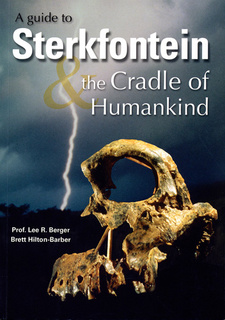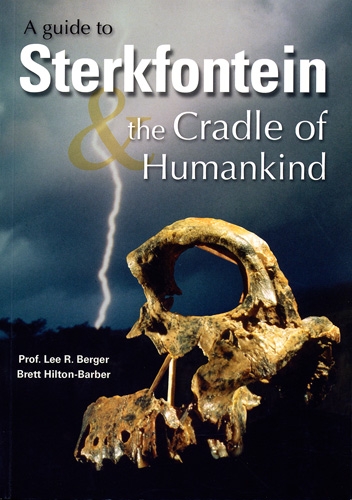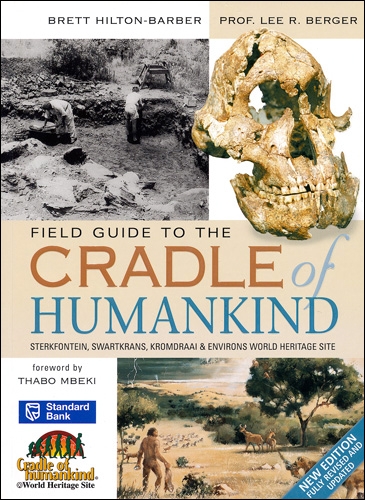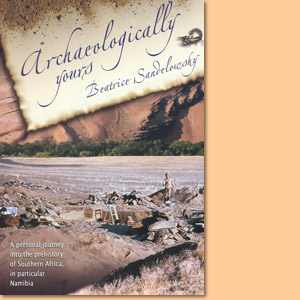A Guide to Sterkfontein and the Cradle of Humankind, by Lee Berger and Brett Hilton-Barber
Professor Dr. Lee Berger and Brett Hilton-Barber designed A Guide to Sterkfontein and the Cradle of Humankind as a most interesting and easy access to the prehistory of South Africa.
Lee R. Berger Brett Hilton-Barber
The Cradle of Humankind
The 47 000 hectare Cradle of Humankind is a unique location blessed with a greater wealth of the prehistory of humankind than almost any other place on Earth. Officially called the Sterkfontein, Swartkrans, Kromdraai and Environs World Heritage Site, the Cradle contains more than 12 major fossil sites and dozens of minor ones that present us with an intriguing mixture of mystery and revelation about much of our ancient past. The Cradle of Humankind lies in the Witwatersrand Basin on the edge of the divide between the highveld grasslands and the more vegetated bushveld in the South African province of Gauteng. It is a summer rainfall area where the higher lying reaches are rolling grasslands while the well-watered valleys have thick riverine bush thinning into mixed woodlands on the slopes. Beneath the 2,6-billion-year-old dolomitic hills found in the Cradle of Humankind lies a series of extensive underground caverns. These geological time capsules have preserved the fossil remnants of tens of thousands of extinct animals, as well as the bones and cultural remains of our own ancestors, the hominins. Included in the Cradle of Humankind is the world-famous Sterkfontein Cave, which has become synonymous with the South African search for human origins. It is located in the dolomitic bedrock underlying the region. This bedrock was once an ancient sea bed and the valley contains some of the world's oldest undistorted rocks, dating back to between 2,6 and 2,8 billion years. That is just over half the age of the Earth itself! The dolomites are the sedimentary remains of an ocean floor that hosted some of the earliest forms of life on Earth - prehistoric blue-green algae. These can still be seen in the rocks today in the form of fossilized stromatolites. Through the ages, the area now designated the Cradle of Humankind has undergone a number of changes. Giant inland seas have come and gone, meteorites have struck near it and dinosaurs have roamed across its surface. The climate has varied considerably, but for the past 3 million years or so, during what scientists call the Plio-Pleistocene (the period when much of human evolution occurred), there has been less variation. During the early stage of the Plio-Pleistocene the Cradle of Humankind enjoyed a subtropical environment. It became much drier as a result of global cooling, yet it has always been conducive to hominin occupation because of the availability of water and shelter, and the varied animal and plant life.
Hominin versus Hominid
Humans and their ancestors have generally been referred to as hominids in the literature of the recent past. Of late, however, a new, scientifically more appropriate term has come into play, namely 'hominin', which will be used in this book. In 1758 botanist Carolus Linnaeus (or Carl von Linné) developed a binomial classification system that uniquely identified different animals and plants. This system is still used today, albeit in a modified form. In the Linnaean system of classification, organisms with similar morphological characteristics were grouped together. Thus, humans are classified as Hominidae because of certain characteristics that differentiate us from the other primates, for example bipedalism (the ability to walk on two legs). The Linnaean classification system also makes provision for superfamilies and the superfamily Hominoidea (hominoids) includes all the living apes. This is the starting point of the present debate on classification.
The traditional view has been to recognize three families of hominoid: the Hylobatidae, the Hominidae and the Pongidae. The Hylobatidae include the so-called lesser apes of Asia, the gibbons and the siamangs. The Hominidae include living humans and closely related fossil apes, such as the australopithecenes, that possess certain characteristics, for example bipedalism, reduced canine size and increased cranial capacity. The Pongidae include the remaining African apes and the orang-utan, whose 'apeness' is recognized in the fact that it is a large-bodied, tail-less, quadrupedal, arboreal primate. Recent genetic research suggests that humans are much more closely related to two other members of the family Pongidae, the common chimpanzee and the bonobo, than either of these species is to the gorilla. [...]
This is an excerpt from the book: A Guide to Sterkfontein and the Cradle of Humankind, by Lee Berger and Brett Hilton-Barber.
Title: A Guide to Sterkfontein and the Cradle of Humankind
Authors: Lee Berger; Brett Hilton-Barber
Publisher: Random House Struik
Imprint: Nature
Cape Town, South Africa 2006
ISBN 9781770072572 / ISBN 978-1-77007-257-2
Softcover, 15x21 cm, 96 pages, throughout colour photos
Berger, Lee und Hilton-Barber, Brett im Namibiana-Buchangebot
A Guide to Sterkfontein and the Cradle of Humankind
This most interesting guide introduces the palaeo-anthropological sites of Sterkfontein and Gladysvale in South Africa as cradle of humankind.
Field Guide to the Cradle of Humankind
This Field Guide to the Cradle of Humankind caused a considerable stir among professionals in the field of palaeoanthropology and sparked a flurry of newspaper articles, journal articles and general debate.
Weitere Buchempfehlungen
Archaeologically yours. A personal journey into the prehistory of Southern Africa/Namibia
Archaeologically yours introduces research methods and their results in the prehistory of southern Africa and the recent history in Namibia.




